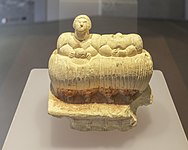Ġgantija
| Templos megalíticos de Malta: Ġgantija | ||
|---|---|---|
|
Patrimonio de la Humanidad de la Unesco | ||
 Vista de las ruinas del templo de Ġgantija. | ||
 Templos megalíticos de Malta: Ġgantija Ubicación en Malta. | ||
| Localización | ||
| País |
| |
| Coordenadas | 36°02′50″N 14°16′09″E / 36.047265, 14.269095 | |
| Datos generales | ||
| Tipo | Cultural | |
| Criterios | iv | |
| Identificación | 132 | |
| Región | Europa y América del Norte | |
| Inscripción | 1980 (IV sesión) | |
| Extensión | 1992 | |
Ġgantija o Ggantija, y también Ggantia, es el nombre de un conjunto de dos templos megalíticos de Malta situados en Xaghra (isla de Gozo, al norte de Malta).
Fueron erigidos durante el Neolítico (entre 3600 y 2500 a. C.) y son por lo tanto anteriores a conjuntos similares como Stonehenge. Se trata de dos de las más antiguas construcciones religiosas complejas que hayan sobrevivido en la región sin haber sido saqueadas, demolidas o enterradas. Pero aún hay algunos más antiguos de la Fase Skorba, ca. 4400 a. C.
Debido a que en ellos se han encontrado estatuas y figuras que parecen representar una diosa madre, se ha considerado que fueron dedicados a este culto. Sin embargo, en maltés, el nombre evoca la expresión "torres gigantes", y según una leyenda, las torres habrían sido construidas por enormes criaturas con el fin de utilizarlas como sitios de adoración.[1] A pesar de todo está muy claro que pertenecen a una representación en arquitectura para ofrendas o culto a una triada de la madreterra, como la que se representa en figura de marfil del tiempo micénico. El último templo creado está en Tarxien/Tarkien en 1800 a. C.
En 1980, los templos megalíticos de Ġgantija fueron declarados Patrimonio de la Humanidad por la Unesco. La declaración se extendió en 1992 a otros templos en la isla de Malta.[2]
Galería de imágenes
[editar]Referencias
[editar]- ↑ De Soldanis, Gozo, Ancient and Modern, Religious and Profane, Book I, pp. 86-88.
- ↑ «Megalithic Temples of Malta». UNESCO Culture Sector. Consultado el 8 de marzo de 2015.
Enlaces externos
[editar]- Heritagemalta.org Página maltesa sobre Ġgantija (en inglés).
- Gozo.gov.mt Página oficial de Ġgantija Archivado el 17 de junio de 2011 en Wayback Machine. (en inglés).
- Página de la Unesco sobre los templos megalíticos de Malta.
Text is available under the CC BY-SA 4.0 license; additional terms may apply.
Images, videos and audio are available under their respective licenses.






